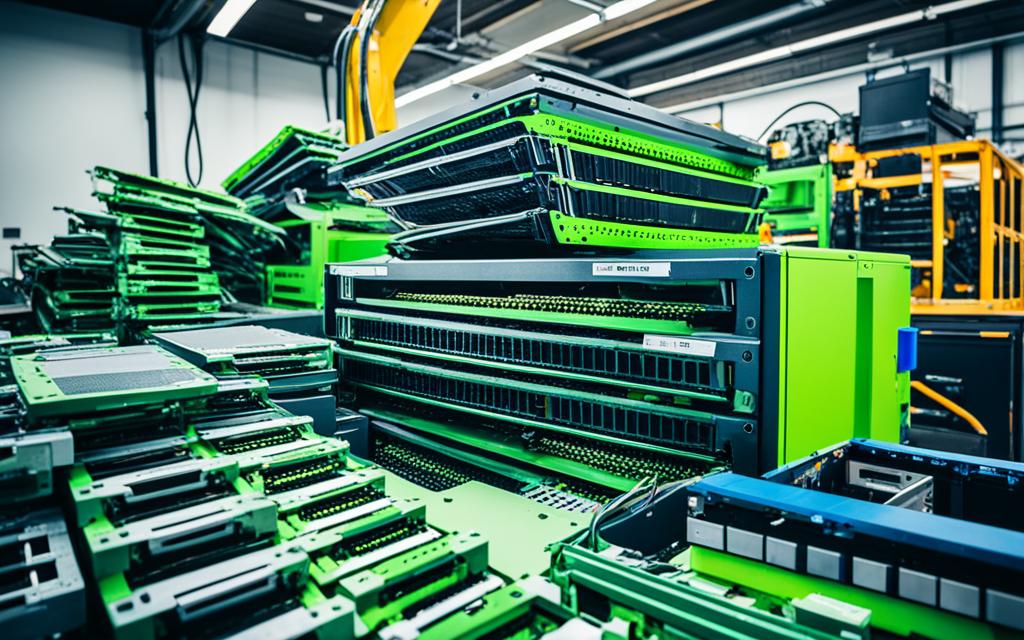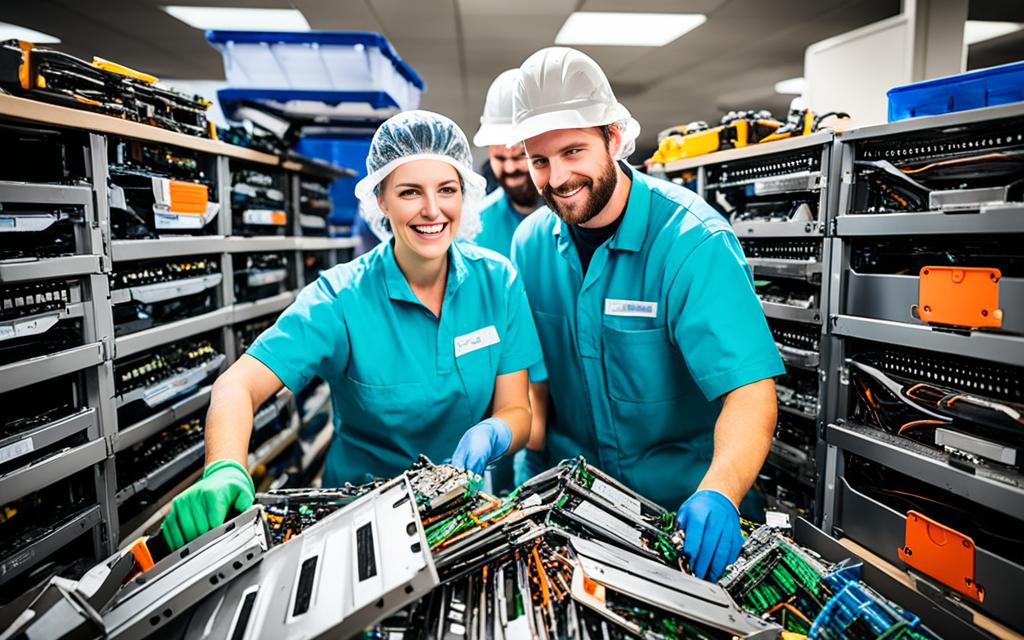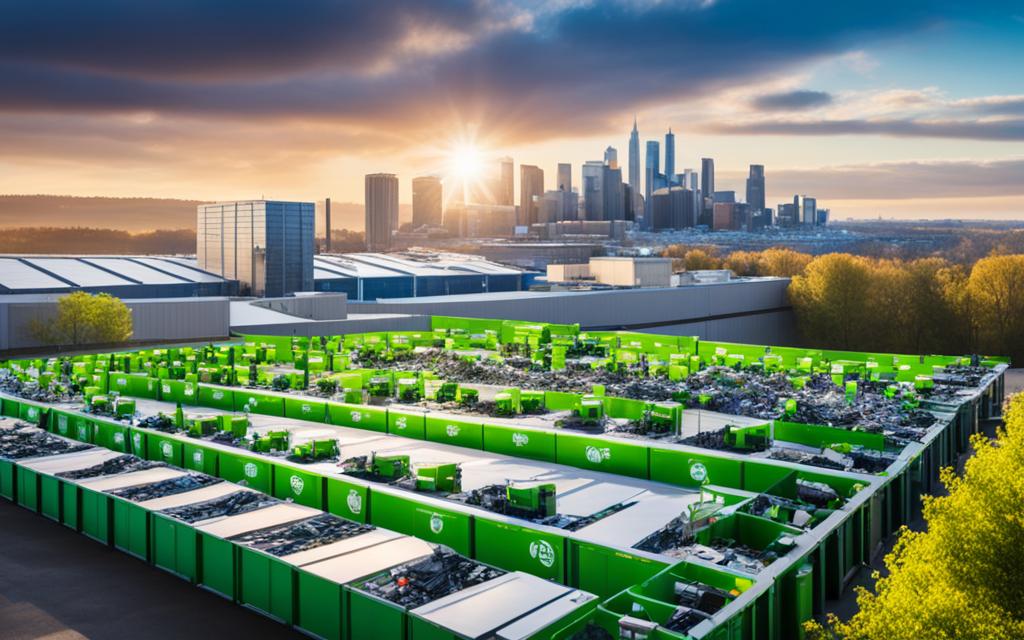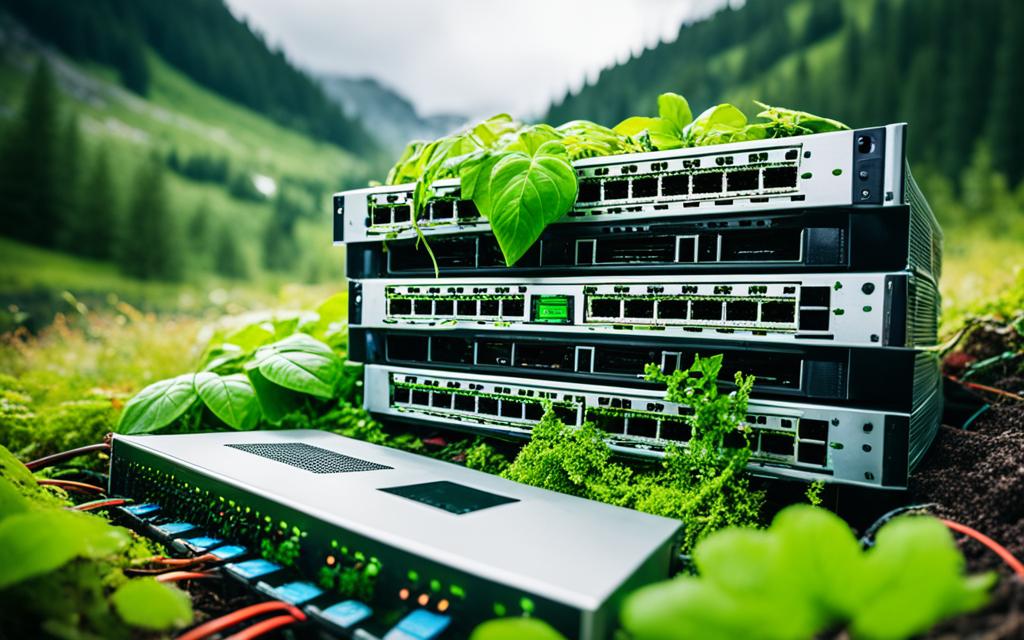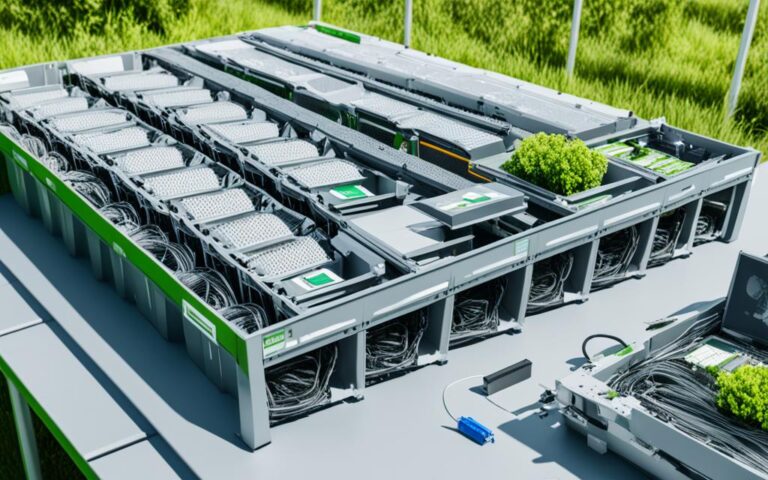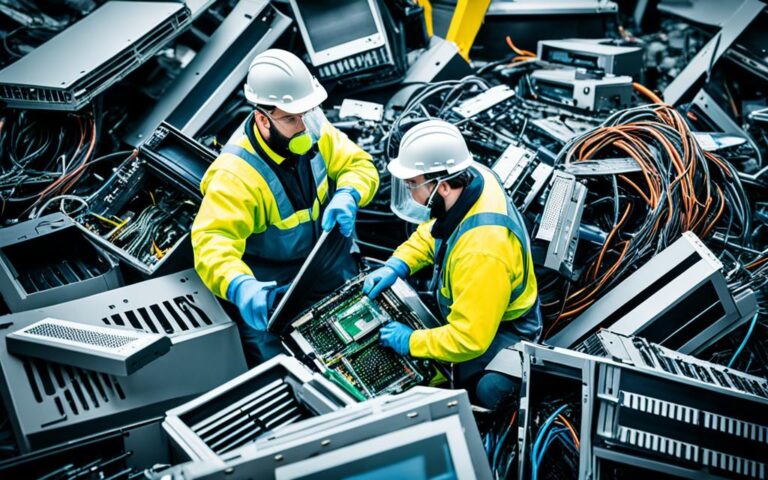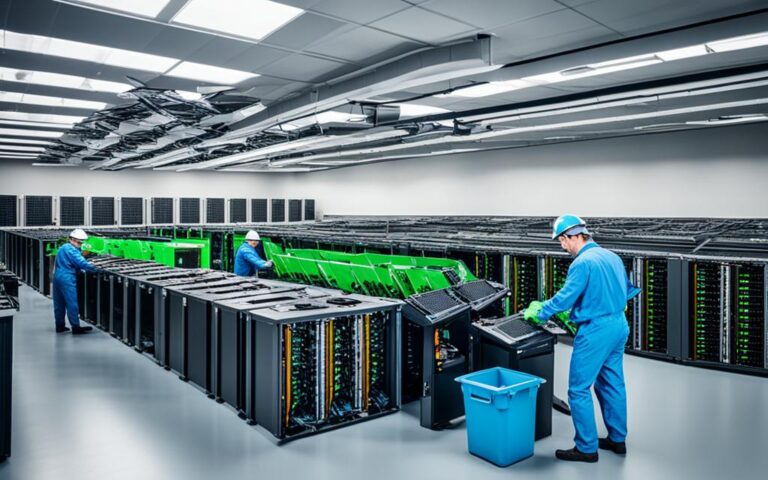Server Recycling: Addressing the Challenge of Obsolete Technology
In today’s rapidly advancing technological landscape, the challenge of managing and recycling obsolete technology, especially in corporate settings, has become a pressing issue. Proper server recycling is crucial to reduce electronic waste and promote environmental sustainability. This article delves into the importance of addressing the challenge of obsolete technology recycling, highlighting the benefits and challenges of corporate IT recycling, as well as the factors shaping its future. We will also explore the concept of Network Recycling and its role in reducing e-waste. Ultimately, we aim to inspire individuals and businesses in the United Kingdom to embrace the green future by participating in efficient server recycling practices.
The Need for Computer Recycling
Electronic waste, or e-waste, is a growing global problem, with computer waste being a significant contributor. The rapid pace of technological advancements leads to the frequent replacement of computers, resulting in a large volume of discarded devices. Proper computer recycling is essential to address this issue and minimize the environmental impact of e-waste. Understanding the need for computer recycling is crucial to promote responsible disposal practices and encourage sustainable resource management.
When it comes to computer recycling, the environmental impact cannot be ignored. E-waste generation has reached alarming levels, with millions of computers being disposed of every year. These discarded devices contain hazardous materials like lead, mercury, and cadmium, which can seep into the soil and water, causing pollution and potential harm to human health.
“Proper computer recycling is crucial to address the environmental impact of e-waste and protect our planet from further harm.”
By recycling computers, we can mitigate these environmental risks. The recycling process involves safely extracting and disposing of hazardous materials, preventing them from contaminating the environment. Additionally, valuable components and materials can be recovered and reused, reducing the need for resource-intensive mining and conserving natural resources.
The Environmental Impact of E-waste Generation
E-waste generation poses a significant threat to the environment due to the toxic substances present in electronic devices. When improperly disposed of in landfills or incinerated, these toxic materials can leach into the soil, polluting water sources and endangering ecosystems. Furthermore, the energy-intensive production of new electronic devices contributes to carbon emissions and resource depletion.
According to the United Nations University, the world produced 53.6 million metric tons of e-waste in 2019, equivalent to the weight of nearly 350 cruise ships. This alarming volume not only highlights the urgent need for computer recycling but also the potential positive impact it can have in reducing e-waste and conserving our planet’s resources.
Computer recycling plays a vital role in addressing the environmental impact of e-waste generation. Through responsible recycling practices, we can divert electronic devices from landfills, reduce pollution, and contribute to a more sustainable future.
| Benefits of Computer Recycling |
|---|
| Reduces e-waste generation |
| Prevents pollution from hazardous materials |
| Conserves natural resources |
| Reduces carbon emissions |
| Creates job opportunities |
Benefits of Computer Recycling
Computer recycling offers numerous economic, social, and environmental benefits. By recycling computers, we can make a significant impact on various aspects of our society and planet.
Landfill Reduction
One of the primary benefits of computer recycling is landfill reduction. Improper disposal of computers can lead to the accumulation of electronic waste in landfills. This not only takes up valuable space but also poses environmental risks. E-waste contains hazardous materials that can seep into the soil and water, polluting ecosystems and endangering human health. By recycling computers, we can reduce the amount of e-waste in landfills, mitigating these risks and promoting a cleaner environment for future generations.
Conservation of Natural Resources
Computer recycling also contributes to the conservation of natural resources. Inside every computer, there are valuable materials such as metals, plastics, and rare earth elements. Extracting and reusing these materials through recycling reduces the demand for raw materials, such as mining ores or drilling for oil. By conserving natural resources, we can minimize the environmental impact of resource extraction, including habitat destruction and carbon emissions. Sustainable computer recycling practices help us build a more resource-efficient and environmentally friendly society.
Economic Growth
Corporate IT recycling can also stimulate economic growth. The recycling industry, including computer recycling, creates job opportunities in various stages of the recycling process, from collection and sorting to refurbishment and resale. Creating a sustainable economy not only benefits the environment but also contributes to job creation and economic stability.
Bridging the Digital Divide
Computer recycling initiatives play a crucial role in bridging the digital divide. Many non-profit organizations and individuals from low-income backgrounds lack access to computers and digital technologies. By recycling and refurbishing computers, we can make these devices accessible to those who need them the most. Bridging the digital divide enables greater educational and economic opportunities for individuals and communities, promoting social equity and inclusivity.
Computer recycling offers a multitude of benefits, ranging from reducing landfill waste and conserving natural resources to fostering economic growth and bridging the digital divide. Embracing computer recycling practices not only contributes to a sustainable future but also empowers individuals and communities to thrive in the ever-evolving digital world.
| Benefits of Computer Recycling | Keywords |
|---|---|
| Landfill Reduction | landfill reduction |
| Conservation of Natural Resources | conservation of natural resources |
| Economic Growth | economic growth |
| Bridging the Digital Divide | bridging the digital divide |
Through computer recycling, we can create a sustainable future by reducing landfill waste, conserving natural resources, promoting economic growth, and bridging the digital divide.
Challenges of Corporate IT Recycling
Corporate IT recycling brings forth several challenges that must be overcome to ensure its successful implementation and long-term sustainability. These challenges span various aspects of the recycling process, including the collection of equipment, sorting and dismantling, data security concerns, reducing recycling costs, and the lack of demand for recycled materials.
- Collection of Equipment: The collection of equipment poses logistical challenges due to the weight and size of IT equipment. Transporting these items to recycling centers can be both heavy and costly, especially for businesses with large quantities of servers, desktops, and other IT devices.
- Sorting and Dismantling: The process of sorting and dismantling IT equipment is time-consuming and labor-intensive. It requires skilled technicians to disassemble the devices, separate the various components, and correctly identify the recyclable materials for proper processing.
- Data Security Concerns: Disposing of computers and other IT equipment raises data security concerns. It is crucial to ensure proper data destruction to protect sensitive information, preventing potential data breaches and safeguarding the privacy of individuals and businesses.
- Reducing Recycling Costs: Implementing recycling technologies can come with significant costs. Some recycling methods and equipment may be expensive, hindering the widespread adoption of recycling practices. Finding cost-effective solutions is essential to make IT recycling economically viable.
- Lack of Demand for Recycled Materials: Despite the importance of recycling, there is often a lack of demand for recycled materials. This can impact the profitability of recycling programs, as the market may not offer adequate incentives for businesses to invest in recycling initiatives.
To overcome these challenges, collaboration between businesses, recycling centers, and regulatory bodies is crucial. Implementing efficient collection systems, investing in advanced sorting technologies, prioritizing data security protocols, exploring cost-effective recycling methods, and promoting the demand for recycled materials are vital steps towards addressing these challenges.
By overcoming these obstacles, corporate IT recycling can become more streamlined, cost-effective, and environmentally impactful. It is through concerted efforts that we can build a sustainable future, ensuring the responsible management of electronic waste and minimizing its adverse effects on both the environment and society as a whole.
Factors Shaping the Future of Corporate IT Recycling
As the world becomes increasingly aware of the environmental impact of electronic waste, several factors are driving the future of corporate IT recycling. These factors are instrumental in promoting sustainability, fostering innovation, and shaping the direction of responsible recycling practices. Three key factors stand out: regulatory compliance, emerging technologies, and evolving consumer behaviors.
Regulatory Compliance: Ensuring Responsible Behavior
Governments worldwide have recognized the importance of addressing the challenge of electronic waste and have implemented strict guidelines to ensure responsible behavior and enforce recycling laws. Regulatory compliance plays a crucial role in shaping the future of corporate IT recycling by holding businesses accountable for their e-waste management practices. By complying with these regulations, companies can contribute to a more sustainable future.
Emerging Technologies: Revolutionizing Recycling
The emergence of technologies like artificial intelligence (AI) and blockchain is revolutionizing the recycling process, making it more efficient, cost-effective, and secure. AI-powered systems can streamline sorting and dismantling processes of IT equipment, increasing recycling efficiency. Blockchain technology provides transparency and traceability, ensuring the secure and accurate tracking of recycled materials. These emerging technologies enable businesses to improve their recycling practices and transform the way electronic waste is managed.
Evolving Consumer Behaviors: Demanding Sustainability
Consumer behaviors are evolving, with an increasing awareness and demand for sustainable products. The shift towards green consumerism is driving businesses to prioritize environmental responsibility and incorporate sustainable practices into their operations. As consumers become more conscious of the environmental impact of electronic waste, they expect corporations to take a proactive approach to recycling. This demand for sustainability is pushing businesses to adopt more environmentally friendly practices, including responsible IT recycling.
By considering these factors – regulatory compliance, emerging technologies, and evolving consumer behaviors – corporations can embrace the future of IT recycling. As technology advances and environmental awareness grows, it becomes imperative for businesses to adapt and incorporate sustainable practices. Through responsible recycling and a commitment to reducing electronic waste, companies can contribute to a circular economy and create a greener, more sustainable future.
Conclusion
In conclusion, addressing the challenge of obsolete technology recycling is essential for creating a sustainable future. E-waste reduction is a pressing environmental concern that requires immediate action. By embracing proper server recycling practices, such as Network Recycling, we can significantly contribute to reducing e-waste and promoting a circular economy.
Efficient server recycling in the United Kingdom is crucial to minimize the environmental impact of electronic waste. Through responsible disposal and recycling, we can conserve valuable resources and prevent the pollution and ecosystem disturbances associated with improper e-waste disposal. Additionally, server recycling initiatives offer economic opportunities by creating job openings in the recycling industry.
Furthermore, server recycling can bridge the digital divide by making refurbished devices accessible to non-profit organizations and low-income individuals. This enables greater digital participation and empowers individuals who may not have the means to access essential technology otherwise. By participating in server recycling initiatives, individuals and businesses can make a positive impact on the environment, contribute to a sustainable future, and foster a more inclusive society.
FAQ
What is server recycling?
Server recycling is the process of disposing of obsolete or unwanted servers in an environmentally responsible manner. This involves dismantling the servers, extracting valuable components, and recycling or refurbishing them for reuse.
Why is server recycling important?
Server recycling is important because it helps reduce electronic waste, minimize the environmental impact of discarded servers, and promote sustainability. It also allows for the conservation of valuable resources and the creation of job opportunities in the recycling industry.
What are the benefits of computer recycling?
Computer recycling offers several benefits, including the conservation of landfill space, the reduction of pollution and ecosystem disturbances, and the conservation of natural resources by reusing valuable materials and rare earth metals. It also promotes economic growth through job creation and helps bridge the digital divide by making refurbished computers accessible to those who cannot afford new ones.
What challenges are faced in corporate IT recycling?
Corporate IT recycling faces challenges such as the collection and transportation of heavy equipment to recycling centers, the time-consuming and labor-intensive process of sorting and dismantling IT equipment, and data security concerns that require proper data destruction. Additionally, reducing recycling costs and creating demand for recycled materials are ongoing challenges in corporate IT recycling.
What factors are shaping the future of corporate IT recycling?
Several factors are shaping the future of corporate IT recycling, including regulatory compliance with recycling laws and guidelines, the emergence of technologies like artificial intelligence and blockchain that improve the efficiency and security of the recycling process, and evolving consumer behaviors that demand sustainable products and practices.
How can server recycling contribute to a sustainable future?
Server recycling can contribute to a sustainable future by reducing the amount of electronic waste generated, conserving valuable resources, creating job opportunities in the recycling industry, and bridging the digital divide by making refurbished computers accessible to those who cannot afford new ones.

